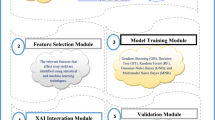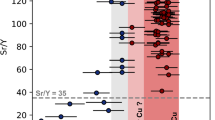Abstract
This paper outlines the process taken to create two separate gold prospectivity maps. The first was created using a combination of several knowledge-driven (KD) techniques. The second was created using a relatively new classification method called random forests (RF). The purpose of this study was to examine the results of the RF technique and to compare the results to that of the KD model. The datasets used for the creation of evidence maps for the gold prospectivity mapping include a comprehensive lake sediment geochemical dataset, interpreted geological structures (form lines), mapped and interpreted faults, lithology, topographic features (lakes), and known Au occurrences. The RF method performed well in that the gold prospectivity map created was a better predictor of the known Au occurrences than the KD gold prospectivity map. This was further validated by a fivefold repetition using a subset of the input training areas. Several advantages to the use of RF include (1) the ability to take both continuous and/or categorical data as variable inputs, (2) an internal, unbiased estimation of the mapping error (out-of-bag error) removing the need for a cross-validation of the final outputs to determine accuracy, and (3) the estimation of importance of each input variable. Efficiency of prediction curves illustrates that the RF method performs better than the KD method. The success rate is significantly higher for the RF method than for the KD method.











Similar content being viewed by others
References
Abedi, M., Norouzi, G. H., & Bahroudi, A. (2012). Support vector machine for multi-classification of mineral prospectivity areas. Computers Geosciences, 46, 272–283.
Agterberg, F. P., & Bonham-Carter, G. F. (2005). Measuring the performance of mineral-potential maps. Natural Resources Research, 14, 1–17.
Aitchison, J. (1986). The statistical analysis of compositional data. New York: Chapman and Hall.
An, P., Moon, W.M., & Bonham-Carter, G.F. (1992). On a knowledge-based approach of integrating remote sensing, geophysical and geological information. In Proceedings IGARSS’92 (pp. 34–38).
An, P., Moon, W. M., & Bonham-Carter, G. F. (1994a). An object-oriented knowledge representation structure for exploration data integration. Nonrenewable Resources, 3, 132–145.
An, P., Moon, W. M., & Bonham-Carter, G. F. (1994b). Uncertainty management in integration of exploration data using the belief function. Nonrenewable Resources, 2, 60–71.
An, P., Moon, W., & Rencz, A. N. (1991). Application of fuzzy theory for integration of geological, geophysical and remotely sensed data. Canadian Journal of Exploration Geophysics, 27, 1–11.
Aspler, L. B., Wisotzek, I. E., Chiarenzelli, R., Losonczy, M. F., Cousens, B. L., McNicoll, V. J., & Davis, W. J. (2001). Paleoproterozoic intracratonic basin processes, from breakup of Kenora to assembly of Laurentia: Hurwitz basin, Nunavut, Canada. Sedimentary Geology, 141–142, 287–318.
Behnia, P., Harris, J. R., Harrison, C., St-Onge, M., Okulitch, A., Irwin, D., & Gordy, S. (2013). Geo mapping frontiers: Compilation and interpretation of geologic structures North of 60°. Geological Survey of Canada Open File: Canada. 7649.
Bonham-Carter, G. F. (1994). Geographic information systems for geoscientists: Modeling with GIS. New York: Pergamon, Elsevier Science Inc.
Breiman, L. (2001). Random forests. Machine Learning, 45, 5–32.
Brodeur, G., El-Hihi, S., & Jebrak, M. (1992). Applications of neural network computing to mineral exploration in the southern Abitibi greenstone belt. In Program with Abstracts-Geological Association of Canada, Mineralogical Association of Canada, Canadian Geophysical Union: Joint Annual Meeting (p 17).
Brown, W. M., Gedeon, T. D., Groves, D. L., & Barnes, R. G. (2000). Artificial neural networks; A new method for mineral prospectivity mapping. Australian Journal of Earth Sciences, 47, 757–770.
Calle, M., & Urrea, V. (2010). Letter to the editor: Stability of random forest measures. Brief Bioinformatics, 12, 86–89.
Carranza, E. J. M. (2009a). Chapter 7: Knowledge-driven modeling of mineral prospectivity. In E. J. M. Carranza (Ed.), Handbook of exploration and environmental geochemistry (pp. 189–247). Amsterdam: Elsevier Science B.V.
Carranza, E. J. M. (2009b). Chapter 8: Data-driven modeling of mineral prospectivity. In E. J. M. Carranza (Ed.), Handbook of exploration and environmental geochemistry (pp. 249–310). Amsterdam: Elsevier Science B.V.
Carranza, E. J. M. (2014). Data-driven evidential belief modeling of mineral potential using few prospects and evidence with missing values. Natural Resources Research,. doi:10.1007/s11053-014-9250-z.
Carranza, E. J. M., & Laborte, A. G. (2015). Random Forest predictive modeling of mineral prospectivity with small numbers of prospects and data with missing values. Computers & Geosciences, 74, 60–70.
Carranza, E. J. M., Woldai, T., & Chikambwe, E. M. (2005). Application of data-driven evidential belief functions to prospectivity mapping for aquamarine-bearing pegmatites, Lundazi District, Zambia. Natural Resources Research, 14, 47–63.
Charbonneau, B.W., & Swettenham, S.S. (1986). Gold occurrence in radio-active calc-silicate float at Sandy beach Lake, Nueltin lake area, District of Keewatin. In: Current Research 1986-A; Geological Survey of Canada, pp. 803–808.
Chung, C. F., & Agterberg, F. P. (1980). Regression models for estimating mineral resources from geological map data. Mathematical Geology, 12, 473–488.
Chung, C. F., & Fabbri, A. G. (2003). Validation of spatial prediction models for landslide hazard mapping. Natural Hazards, 30, 451–472.
Doan, H. T., & Foody, G. M. (2007). Increasing soft classification accuracy through the use of an ensemble classifier. International Journal of Remote Sensing, 28, 4609–4623.
Gislason, P., Benediktsson, J., & Sveinsson, J. (2006). Random Forests for land cover classification. Pattern Recognition Letters, 27, 294–300.
Grunsky, E. C., Mueller, U. A., & Corrigan, D. (2014). A study of the lake sediment geochemistry of the Melville Peninsula using multivariate methods: Applications for predictive geological mapping. Journal of Geochemical Exploration, 141, 15–41.
Hanmer, S., Sandeman, H. A., Davis, W. J., Aspler, L. B., Rainbird, R. H., Ryan, J. J., et al. (2004). Neoarchean tectonic setting of the Central Hearne supracrustal belt, western Churchill Province, Nunavut, Canada. Precambrian Research, 134, 63–83.
Harris, J. R. (1989). Data integration for gold exploration in eastern Nova Scotia using a GIS. Proceedings of Remote Sensing for Exploration Geology (pp. 285–292). Alberta: Calgary.
Harris, J. R., Grunsky, E., Behnia, P., & Corrigan, D. (2015). Data-and knowledge-driven mineral prospectivity maps for Canada’s North. Ore Geology Reviews,. doi:10.1016/j.oregeorev.2015.01.004.
Harris, D. A., & Pan, R. (1999). Mineral favourability mapping: a comparison of artificial networks, logistic regression and discriminant analysis. Natural Resources Research, 8, 93–109.
Harris, J. R., Sanborn-Barrie, M., Panagapko, D. A., Skulski, T., & Parker, J. R. (2006). Gold prospectivity maps of the Red Lake greenstone belt: application of GIS technology. Canadian Journal of Earth Sciences, 43, 865–893.
Harris, J. R., Wilkinson, L., Heather, K., Fumerton, S., Bernier, M. A., Ayer, J., & Dahn, R. (2001). Application of GIS processing techniques for producing mineral prospectivity maps—A case study: Mesothermal Au in the Swayze greenstone belt, Ontario, Canada. Natural Resources Research, 10, 91–124.
McCurdy, M.W., McNeil, R. J., Day, S.J.A., & Pehrsson, S.J. (2012). Regional lake sediment and water geochemical data, Nueltin lake area, Nunavut (NTS 65A, 65B and 65C), Geological Survey of Canada Open File 6986, 1 CD-ROM.
Menze, B. H., Kelm, B. M., Masuch, R., Himmelreich, U., Bachert, P., Petrich, W., & Hamprecht, F. A. (2009). A comparison of random forest and its Gini importance with standard chemometric methods for the feature selection and classification of spectral data. BMC Bioinformatics, 10, 213.
Oshiro, T. M., Perez, P. S., & Baranauskas, J. A. (2012). How many trees in a random forest? In P. Perner (Ed.), Machine learning and data mining in pattern recognition. Lecture notes in computer science (Vol. 7376, pp. 154–168). Berlin: Springer.
Paul, D, Hanmer, S., Tella, S., Peterson, T.D., & Lecheminant, A.N. (2002). Geological Survey of Canada, Open File 4236, 1 sheet; 1 CD-ROM.
Porwal, A., Carranza, E. J. M., & Hale, M. (2003). Artificial neural networks for mineral-prospectivity mapping: A case study from Aravalli Province, Western India. Natural Resources Research, 12, 156–171.
Reddy, R. K. T., & Bonham-Carter, G. F. (1991). A decision-tree approach to mineral potential mapping in Snow Lake area. Manitoba, Canadian Journal of Remote Sensing, 17, 191–200.
Rodriguez-Galiano, V. F., Chica-Olmo, M., & Chica-Rivas, M. (2014). Predictive modelling of gold potential with the integration of multisource information based on random forest: A case study on the Rodalquilar area, Southern Spain. International Journal of Geographical Information Science, 28, 1336–1354.
Scott, J.M.J. (2012). Paleoproterzoic (1.75 Ma) granitoid rocks and uranium mineralization on the Baker Lake-Thelon Basin region, Nunavut. B.Sc. thesis, Department of Earth Science, Carleton University, unpublished.
Scott, J.M.J, Peterson, T.D., & McCurdy, W.W. (2012). U, Th and REE occurrences within the Nueltin granite suite at Nueltin lake, Nunavut, recent observations, Geological Survey of Canada, Current Research 2012-1.
Singer, D. A., & Kouda, R. (1996). Application of feed forward neural network in search for Kuroko deposits in the Hokuroku district, Japan. Mathematical Geology, 28, 1017–1023.
Van Breeman, O., Peterson, T. D., & Sanderman, H. A. (2005). U-Pb zircon geochronology and Nd isotope geochemistry of Proterozoic granitoids in the western Churchill Province: Intrusive age pattern and Archean source domains. Canadian Journal of Earth Science, 42, 339–377.
Waske, B., & Braun, M. (2009). Classifier ensembles for land cover mapping using multitemporal SAR imagery. ISPRS Journal of Photogrammetry and Remote Sensing, 64, 450–457.
Wright, D.F., & Bonham-Carter, G.F. (1996). VHMS favourability mapping with GIS-based integration models, Chisel Lake-Anderson Lake Area. In G. F. Bonham-Carter, A. G. Galley, & G. E. M. Hall (Eds.), EXTECH I: A multidisciplinary approach to massive sulphide research in the Rusty Lake-Snow Lake Greenstone Belts. Manitoba: Geological Survey of Canada, Bulletin 426, pp. 339–376 and pp. 387–401. Special Publication 44: 21.
Zuo, R., & Carranza, E. J. M. (2011). Support vector machine: A tool for mapping mineral prospectivity. Computers Geosciences, 37, 1967–1975.
Acknowledgments
This work was supported and funded under the Geo-Mapping for Energy and Minerals (GEM) program at the Geological Survey of Canada (GSC). We would also like to thank Algonquin College located in Ottawa, Canada for their support.
Author information
Authors and Affiliations
Corresponding author
Rights and permissions
About this article
Cite this article
McKay, G., Harris, J.R. Comparison of the Data-Driven Random Forests Model and a Knowledge-Driven Method for Mineral Prospectivity Mapping: A Case Study for Gold Deposits Around the Huritz Group and Nueltin Suite, Nunavut, Canada. Nat Resour Res 25, 125–143 (2016). https://doi.org/10.1007/s11053-015-9274-z
Received:
Accepted:
Published:
Issue Date:
DOI: https://doi.org/10.1007/s11053-015-9274-z




